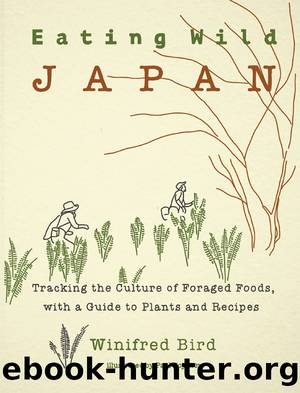Eating Wild Japan by Winifred Bird

Author:Winifred Bird
Language: eng
Format: epub
Publisher: Stone Bridge Press
After we finished our coffee and tea, Okamoto offered to drive me over to the docks. He parked across from the seawall and strode confidently through one of the gaps. Despite his grandfatherly white hair and hand-knit sweater, I realized that as the co-op president he was likely one of the most powerful members of this seagoing community. I followed timidly behind him. The far side of the wall was a hive of activity. On this one dock perhaps ten families were at work processing their morning haul. Each had set up a station comprising colored crates, pulleys, and piles of seaweed alongside furiously busy men and women in rain slickers. A steady stream of small boats pulled up laden with wakame, which was winched up gradually via claptrap bamboo pulley systems. Kites and crows hovered overhead, no doubt hoping for a scrap of flesh among all those sea vegetables. Men and women hunched on upturned crates divided the wakame into leaves, stems, and the prized mekabu. The separated parts were then transferred to large boilers where college boys on temporary spring-break jobs stirred them into steaming vats of water. After a minute or two of blanching the wakame was plunged into cold water, pressed between plastic crates to remove excess liquid, and tossed with salt in a machine resembling a miniature cement mixer. Later, the salted, semi-dried wakame would be trimmed, packaged, and sold over the course of three or four months. Some of the crop was also dried for longer storage. Wakame can be eaten fresh as well, but only for a day or two after harvest, making it a seasonal delicacy enjoyed mainly in fishing villages and surrounding areas.
As we stood on the dock, a grizzled, deeply bronzed old man pulled in on a boat with a hako megane box on the prow and a hull full of wild wakame. So the wildcrafters really did still exist! When Okamoto told him I was interested in his haul, he smiled conspiratorially and said it was much tastier than the cultivated stuff. He then proceeded to pull out a knife, slice off a massive tangle, and insist that I take it home to try for myself. In fact, he insisted (to the horror of my stomach) that I do a taste test right then and there. Okamoto quickly procured a bag of farmed wakame from a worker stationed nearby so that I could make a proper comparison. The most apparent difference was the texture. The cultivated wakame was nearly smooth aside from some fine pores and hairs on the blades, while the blades of the wild variety were as wrinkled as an unironed sheet. The wild wakame was also a bit closer to al dente pasta than the silky, rather insubstantial farmed variety. I told the fisherman that the wild variety tasted less harsh and perhaps sweeter than the cultivated one, although the difference was nearly imperceptible. Apparently gratified by these impressions, he turned back to his task of unloading the boat.
Download
This site does not store any files on its server. We only index and link to content provided by other sites. Please contact the content providers to delete copyright contents if any and email us, we'll remove relevant links or contents immediately.
Machine Learning at Scale with H2O by Gregory Keys | David Whiting(4106)
Never by Ken Follett(3762)
Fairy Tale by Stephen King(3193)
The Man Who Died Twice by Richard Osman(2979)
Will by Will Smith(2770)
Friends, Lovers, and the Big Terrible Thing by Matthew Perry(2100)
The Becoming by Nora Roberts(2062)
A Short History of War by Jeremy Black(1744)
Go Tell the Bees That I Am Gone by Diana Gabaldon(1670)
515945210 by Unknown(1583)
A Game of Thrones (The Illustrated Edition) by George R. R. Martin(1563)
443319537 by Unknown(1451)
The 1619 Project by Unknown(1366)
Works by Richard Wright(1247)
Meditations (Modern Library) by Marcus Aurelius(1229)
Going There by Katie Couric(1140)
472244821 by Unknown(1129)
book title by 2023(1084)
264099364 by Unknown(1041)
